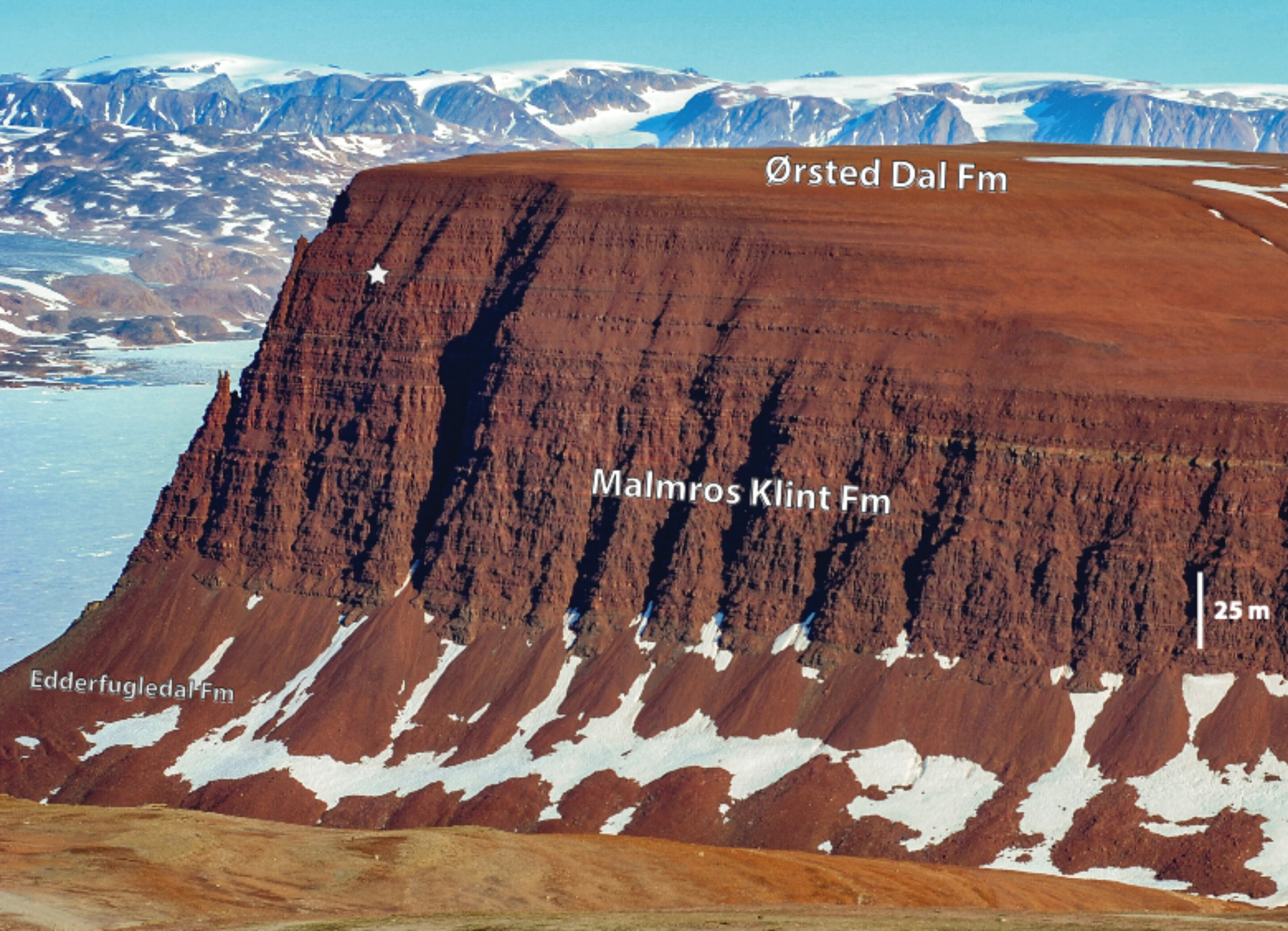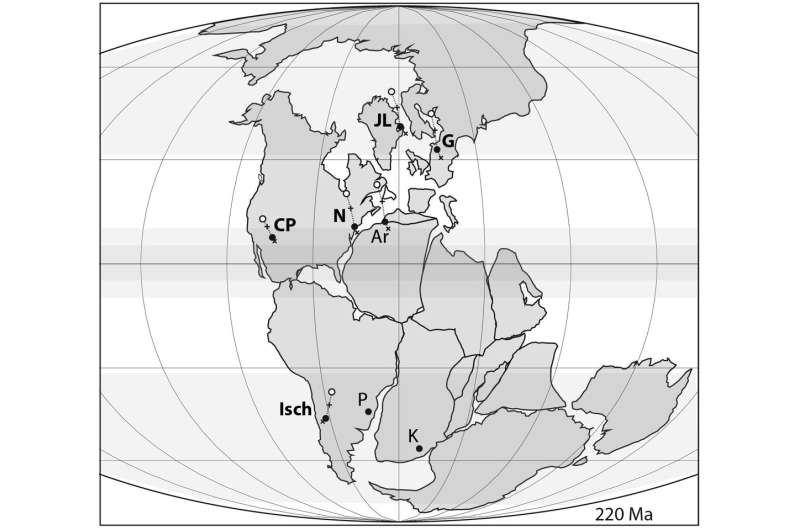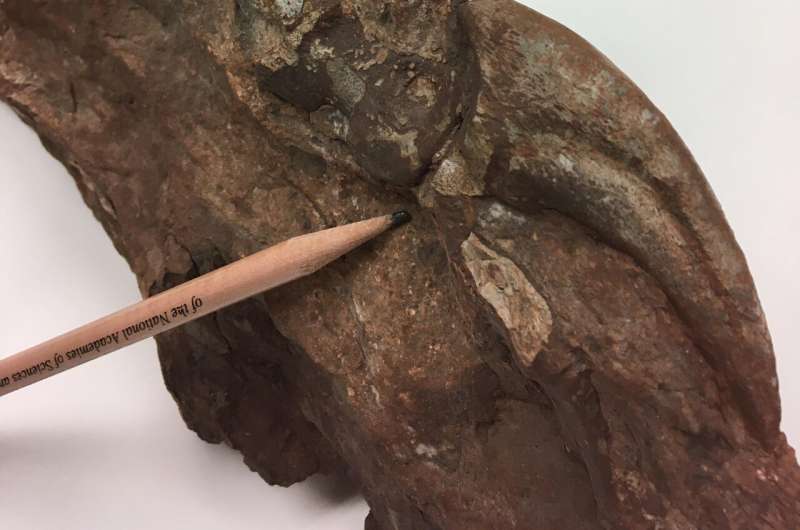
[ad_1]

A cliff in the Jameson terrestrial basin in east-central Greenland, the most northerly site of sauropodomorph fossils. The labels indicate several sets of layers that have helped researchers accurately date the oldest sauropodomorph fossils in North America. Credit: Lars Clemmensen
A new article refines estimates of when herbivorous dinosaurs had to cross North America on a trek north to reach Greenland, and highlights an intriguing climatic phenomenon that may have helped them along the journey.
The study, published today in Proceedings of the National Academy of Sciences, is written by Dennis Kent, Associate Researcher at the Lamont-Doherty Earth Observatory at Columbia University, and Lars Clemmensen at the University of Copenhagen.
Earlier estimates suggested that the sauropodomorphs – a group of long-necked herbivorous dinosaurs that ultimately included the Brontosaurus and the Brachiosaurus – arrived in Greenland between 225 and 205 million years ago. But by painstakingly matching ancient patterns of magnetism in rock layers from fossil sites in South America, Arizona, New Jersey, Europe and Greenland, the new study offers a more accurate estimate: it suggests that sauropodomorphs manifested in what is now Greenland around 214 million years ago. At the time, the continents were all united, forming the Pangea supercontinent.
With this new, more precise estimate, the authors were faced with another question. Fossil records show that sauropodomorphic dinosaurs first appeared in Argentina and Brazil around 230 million years ago. So why did it take them so long to expand into the northern hemisphere?

The map shows how the main continents were organized 220 million years ago in the Pangea supercontinent. “Isch” and “P” mark locations with sauropodomorph fossils up to 233 million years old. Herbivorous dinosaurs only reached Jameson Land in Greenland (“JL”) about 214 million years ago. Credit: Dennis Kent and Lars Clemmensen
“In principle, the dinosaurs could have walked from pole to pole,” Kent explained. “There was no ocean in between. There were no big mountains. And yet it took 15 million years. It’s like the snails could have done it faster.” He calculates that if a herd of dinosaurs walked only a mile a day, it would take them less than 20 years to make the trip between South America and Greenland.
Oddly enough, Earth was in the middle of a huge drop in atmospheric CO2 around the time the sauropodomorphs would have migrated 214 million years ago. Until about 215 million years ago, the Triassic Period had seen extremely high CO emissions2 levels, at about 4,000 parts per million, about 10 times higher than today. But between 215 and 212 million years ago, CO2 concentration halved, falling to about 2000 ppm.
Although the timing of these two events – the fall of CO2 and the sauropodomorph migration – could be pure coincidence, Kent and Clemmensen believe they may be related. In the article, they suggest that the milder levels of CO2 may have helped remove climatic barriers that may have trapped sauropodomorphs in South America.
On Earth, areas around the equator are hot and humid, while areas adjacent to low latitudes tend to be very dry. Kent and Clemmensen say on a CO supercharged planet2, the differences between these climate belts may have been extreme – perhaps too extreme for sauropodomorphic dinosaurs to cross.

A claw from a bipedal sauropodomorph (Plateosaurus) from the Jameson Land site in eastern Greenland. Parts of the animal were discovered in 1995 by Farish Jenkins (Harvard), Neil Shubin (U Penn), Lars Clemmensen (Copenhagen) and others. It is the oldest known specimen in the region. Credit: Dennis Kent
“We know that with a higher CO2, the dry gets drier and the humidity gets wetter, ”said Kent. 230 million years ago, CO2 conditions could have made the arid belts too dry to withstand the movements of large herbivores which need to eat a lot of vegetation to survive. The tropics, too, may have been enclosed in rainy, monsoon-like conditions that may not have been ideal for sauropodomorphs. There is little evidence that they ventured outside the temperate mid-latitude habitats to which they were adapted in Argentina and Brazil.
But when the CO2 levels dropped 215 to 212 million years ago, perhaps the tropics became milder and arid regions became less dry. There may have been passages, such as along rivers and chains of lakes, that would have helped support herbivores along the 6,500 mile journey to Greenland, where their fossils are now abundant. Back then, Greenland would have had a similar temperate climate to New York State today, but with much milder winters, as there were no polar ice caps at that time.
“Once we got to Greenland, it looked like they had settled down,” Kent said. “They dragged like a long fossil disc after that.”
The idea that a dip in CO2 could have helped these dinosaurs overcome a climate barrier is speculative but plausible, and that seems to be backed up by the fossil record, Kent said. Sauropodomorph body fossils have not been found in the tropics and arid regions of this period – although their footprints sometimes appear – suggesting that they did not linger in these areas.
Then Kent hopes to continue working to better understand the great CO2 dip, including what caused it and how fast CO2 the levels have dropped.
New Swiss Dinosaur Discovery Fills Gap in Sauropod Evolutionary History
Dennis V. Kent el al., “Northward dispersion of dinosaurs from Gondwana to Greenland in the mid-Norian trough (215–212 Ma, Upper Triassic) of atmospheric pCO2”, PNAS (2021). www.pnas.org/cgi/doi/10.1073/pnas.2020778118
Provided by Earth Institute at Columbia University
Quote: CO2 drop may have helped dinosaurs walk from South America to Greenland (2021, February 15) Retrieved February 15, 2021 from https://phys.org/news/2021-02-co2- dip-dinosaurs-south-america.html
This document is subject to copyright. Apart from any fair use for study or private research, no part may be reproduced without written permission. The content is provided for information only.
[ad_2]
Source link